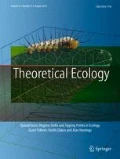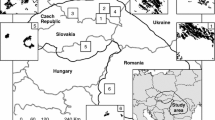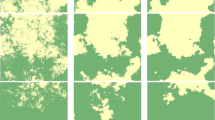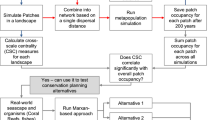Abstract
Understanding and assessing landscape connectivity is often a primary goal when studying patchy or spatially structured populations. It is commonly accepted that the matrix plays a role in determining connectivity; however, it is not clear how the process of assessing connectivity is impacted by different ways in which the matrix may be represented, particularly if matrix structure is generalized to expedite analysis. We conducted a controlled experiment using computer simulations to evaluate the impact of increasing levels of matrix generalization on connectivity assessment using a constant arrangement of habitat patches. We varied matrix generalization for six simulated landscape patterns by adjusting the number of classes and level of pattern grain in 16 ways to yield sets of landscapes for which the matrix ranged from not generalized (i.e., heterogeneous) to completely generalized (i.e., homogeneous) while habitat placement was held constant. Least-cost paths were calculated for each landscape, and a spatial interaction model (SIM) was implemented to model the counts of patch inflows (immigration) and pairwise exchange. Applying a SIM allowed us to generate absolute outputs and explicitly compare the effect of changes to matrix generalization on connectivity. We found that both assessment of connections (i.e., measured distance and spatial delineation of least-cost paths) and patch inflows/pairwise exchange were highly sensitive to matrix generalization and that effects were inconsistent and unpredictable across the range of matrix representations, especially when estimating connectivity for individual patches. We conclude that matrix pattern may have an underappreciated effect on connectivity and that least-cost path delineation and connectivity assessment may be very sensitive to generalizations of the matrix. We suggest that sensitivity analysis of the matrix representation should be performed when conducting connectivity analyses.






Similar content being viewed by others
References
Adriaensen F, Chardon JP, De Blust G et al (2003) The application of ‘least-cost’ modelling as a functional landscape model. Landsc Urban Plan 64(4):233–247
Andren H (1994) Effects of habitat fragmentation on birds and mammals in landscapes with different proportions of suitable habitat—a review. Oikos 71(3):355–366
Baguette M, Blanchet S, Legrand D, Stevens VM, Turlure C (2013) Individual dispersal, landscape connectivity and ecological networks. Biol Rev 88(2):310–326
Baum KA, Haynes KJ, Dillemuth FP, Cronin JT (2004) The matrix enhances the effectiveness of corridors and stepping stones. Ecology 85(10):2671–2676
Beaudry F, deMaynadier PG, Hunter ML Jr (2008) Identifying road mortality threat at multiple spatial scales for semi-aquatic turtles. Biol Conserv 141(10):2550–2563
Beier P, Majka DR, Newell SL (2009) Uncertainty analysis of least-cost modeling for designing wildlife linkages. Ecol Appl 19(8):2067–2077
Bender DJ, Fahrig L (2005) Matrix structure obscures the relationship between interpatch movement and patch size and isolation. Ecology 86(4):1023–1033
Bender DJ, Tischendorf L, Fahrig L (2003) Using patch isolation metrics to predict animal movement in binary landscapes. Landsc Ecol 18(1):17–39
Bossenbroek JM, Kraft CE, Nekola JC (2001) Prediction of long-distance dispersal using gravity models: zebra mussel invasion of inland lakes. Ecol Appl 11(6):1778–1788
Bossenbroek JM, Johnson LE, Peters B, Lodge DM (2007) Forecasting the expansion of zebra mussels in the United States. Conserv Biol 21(3):800–810
Calabrese JM, Fagan WF (2004) A comparison-shopper’s guide to connectivity metrics. Front Ecol Environ 2(10):529–536
Cattarino L, McAlpine CA, Rhodes JR (2013) The consequences of interactions between dispersal distance and resolution of habitat clustering for dispersal success. Landsc Ecol 28(7):1321–1334
Collinge SK, Palmer TM (2002) The influences of patch shape and boundary contrast on insect response to fragmentation in California grasslands. Landsc Ecol 17(7):647–656
Cooley HS, Wielgus RB, Koehler G, Maletzke B (2009) Source populations in carnivore management: cougar demography and emigration in a lightly hunted population. Anim Conserv 12(4):321–328
Crooks KR, Sanjayan M (2006) Connectivity conservation: maintaining connections for nature. In: Crooks KR, Sanjayan M (eds) Connectivity conservation. Cambridge University Press, New York, pp 1–20
Cushman SA, Landguth EL (2010) Spurious correlations and inference in landscape genetics. Mol Ecol 19:3592–3602
Cushman SA, McRae B, Adriaensen F, Beier P, Shirley M, Zeller K (2013) Biological corridors and connectivity. In: Macdonald DW, Willis KJ (eds) Key topics in conservation biology 2. John Wiley & Sons, West Sussex, pp 384–404
Dale VH, Gardner RH (1987) Assessing regional impacts of growth declines using a forest succession model. J Environ Manag 24(1):83–93
Driscoll DA, Banks SC, Barton PS, Lindenmayer DB, Smith AL (2013) Conceptual domain of the matrix in fragmented landscapes. Trends Ecol Evol 28(10):605–613
Epperson BK, McRae BH, Scribner K, Cushman SA, Rosenberg MS, Fortin M-J, James PMA, Murphy M, Manel S, Legendre P, Dale MRT (2010) Utility of computer simulations in landscape genetics. Mol Ecol 19:3549–3564
Eycott AE, Stewart GB, Buyung-Ali LM, Bowler DE, Watts K, Pullin AS (2012) A meta-analysis on the impact of different matrix structures on species movement rates. Landsc Ecol 27(9):1263–1278
Fahrig L (1991) Simulation methods for developing general landscape- level hypotheses of single species dynamics. In: Turner MG, Gardner RH (eds) Quantitative methods in landscape ecology. Springer-Verlag, New York, pp 417–442
Fahrig L (2007) Landscape heterogeneity and metapopulation dynamics. In: Wu J, Hobbs R (eds) Key topics in landscape ecology. Cambridge University Press, Cambridge, pp 78–91
Fahrig L, Merriam G (1985) Habitat patch connectivity and population survival. Ecology 66(6):1762–1768
Fischer M (2006) Spatial analysis and geocomputation. Springer, New York
Fotheringham AS, O’Kelly ME (1989) Spatial interaction models: formulations and applications. Kluwer Academic Publishers, Dordrecht
Gardner RH, Gustafson EJ (2004) Simulating dispersal of reintroduced species within heterogeneous landscapes. Ecol Model 171(4):339–358
Goodwin BJ, Fahrig L (2002) How does landscape structure influence landscape connectivity? Oikos 99(3):552–570
Gustafson EJ, Gardner RH (1996) The effect of landscape heterogeneity on the probability of patch colonization. Ecology 77(1):94–107
Hanski I (1999) Metapopulation ecology. Oxford series in ecology and evolution. Oxford University Press, Oxford
Iosif R (2012) Railroad-Associated Mortality Hot Spots for A Population of Romanian Hermann’s Tortoise (Testudo Hermanni Boettgeri): A Gravity Model for Railroad-Segment Analysis. Procedia Environmental Sciences 14:123–131
Kadoya T (2009) Assessing functional connectivity using empirical data. Popul Ecol 51(1):5–15
Kanagaraj R, Wiegand T, Kramer-Schadt S, Goyal SP (2013) Using individual-based movement models to assess inter-patch connectivity for large carnivores in fragmented landscapes. Biol Conserv 167:298–309
Kindlmann P, Burel F (2008) Connectivity measures: a review. Landsc Ecol 23(8):879–890
King AW, With KA (2002) Dispersal success on spatially structured landscapes: when do spatial pattern and dispersal behavior really matter? Ecol Model 147(1):23–39
Kool JT, Paris CB, Barber PH, Cowen RK (2011) Connectivity and the development of population genetic structure in Indo-West Pacific coral reef communities. Glob Ecol Biogeogr 20(5):695–706
Kool JT, Moilanen A, Treml EA (2013) Population connectivity: recent advances and new perspectives. Landsc Ecol 28(2):165–185
Landguth EL, Hand BK, Glassy J, Cushman SA, Sawaya MA (2012) UNICOR: a species connectivity and corridor network simulator. Ecography 35 (1):9-14
Lechner AM, Reinke KJ, Wang Y, Bastin L (2013) Interactions between landcover pattern and geospatial processing methods: effects on landscape metrics and classification accuracy. Ecol Complex 15:71–82
Lookingbill TR, Gardner RH, Ferrari JR, Keller CE (2010) Combining a dispersal model with network theory to assess habitat connectivity. Ecol Appl 20(2):427–441
Luque S, Saura S, Fortin M-J (2012) Landscape connectivity analysis for conservation: insights from combining new methods with ecological and genetic data PREFACE. Landsc Ecol 27(2):153–157
McRae BH, Dickson BG, Keitt TH, Shah VB (2008) Using circuit theory to model connectivity in ecology, evolution, and conservation. Ecology 89(10):2712–2724
Moilanen A (2011) On the limitations of graph-theoretic connectivity in spatial ecology and conservation. J Appl Ecol 48(6):1543–1547
Moilanen A, Nieminen M (2002) Simple connectivity measures in spatial ecology. Ecology 83(4):1131–1145
Murphy HT, Lovett-Doust J (2004) Context and connectivity in plant metapopulations and landscape mosaics: does the matrix matter? Oikos 105(1):3–14
Murphy MA, Dezzani R, Pilliod DS, Storfer A (2010) Landscape genetics of high mountain frog metapopulations. Mol Ecol 19(17):3634–3649
Oshan T (2016) A primer for working with the spatial interaction modeling (SpInt) module in the python spatial analysis library (PySAL). Region 3(2):R11–R23
Pauli BP, McCann NP, Zollner PA, Cummings R, Gilbert JH, Gustafson EJ (2013) SEARCH: spatially explicit animal response to composition of habitat. PLoS One 8(5):e64656
Rayfield B, Fortin M-J, Fall A (2010) The sensitivity of least-cost habitat graphs to relative cost surface values. Landsc Ecol 25(4):519–532
Revilla E, Wiegand T, Palomares F, Ferreras P, Delibes M (2004) Effects of matrix heterogeneity on animal dispersal: from individual behavior to metapopulation-level parameters. Am Nat 164(5):E130–E153
Ricketts TH (2001) The matrix matters: effective isolation in fragmented landscapes. Am Nat 158(1):87–99
Rubio L, Rodriguez-Freire M, Mateo-Sanchez MC, Estreguil C, Saura S (2012) Sustaining forest landscape connectivity under different land cover change scenarios. Forest Systems 21(2):223–235
Saupe D (1988) Algorithms for random fractals. In: Petigen HO, Saupe D (eds) The science of fractal images. Springer-Verlag, New York, pp 71–113
Sawyer SC, Epps CW, Brashares JS (2011) Placing linkages among fragmented habitats: do least-cost models reflect how animals use landscapes? J Appl Ecol 48(3):668–678
Schooley RL, Branch LC (2011) Habitat quality of source patches and connectivity in fragmented landscapes. Biodivers Conserv 20(8):1611–1623
Sen A, Smith TE (1995) Gravity models of spatial interaction behavior. Advances in spatial and network economics. Springer, Berlin
Shima JS, Noonburg EG, Phillips NE (2010) Life history and matrix heterogeneity interact to shape metapopulation connectivity in spatially structured environments. Ecology 91(4):1215–1224
Szabo S, Novak T, Elek Z (2012) Distance models in ecological network management: a case study of patch connectivity in a grassland network. J Nat Conserv 20(5):293–300
Taylor PD, Fahrig L, Henein K, Merriam G (1993) Connectivity is a vital element of landscape structure. Oikos 68(3):571–573
Urban DL, Minor ES, Treml EA, Schick RS (2009) Graph models of habitat mosaics. Ecol Lett 12(3):260–273
Vandermeer J, Carvajal R (2001) Metapopulation dynamics and the quality of the matrix. Am Nat 158(3):211–220
Villard MA, Metzger JP (2014) Beyond the fragmentation debate: a conceptual model to predict when habitat configuration really matters. J Appl Ecol 51(2):309–318
Vogt P, Ferrari JR, Lookingbill TR, Gardner RH, Riitters KH, Ostapowicz K (2009) Mapping functional connectivity. Ecol Indic 9(1):64–71
Wilson AG (1967) A statistical theory of spatial distribution models. Transp Res 1(3):253
Wilson A (2010) Entropy in urban and regional modelling: retrospect and prospect. Geogr Anal 42(4):364–394
With KA, Gardner RH, Turner MG (1997) Landscape connectivity and population distributions in heterogeneous environments. Oikos 78(1):151–169
Zeller KA, McGarigal K, Whiteley AR (2012) Estimating landscape resistance to movement: a review. Landsc Ecol 27(6):777–797
Ziolkowska E, Ostapowicz K, Radeloff VC, Kuemmerle T (2014) Effects of different matrix representations and connectivity measures on habitat network assessments. Landsc Ecol 29(9):1551–1570
Acknowledgements
We would like to thank the two anonymous reviewers for their comments, suggestions, and helpful feedback on a previous version of this manuscript.
Funding
This work was supported by funding from Alberta Innovates - Technology Futures, Alberta Enterprise and Advanced Education and the University of Calgary.
Author information
Authors and Affiliations
Corresponding author
Rights and permissions
About this article
Cite this article
Koenig, S.J., Bender, D.J. Generalizing matrix structure affects the identification of least-cost paths and patch connectivity. Theor Ecol 11, 95–109 (2018). https://doi.org/10.1007/s12080-017-0351-2
Received:
Accepted:
Published:
Issue Date:
DOI: https://doi.org/10.1007/s12080-017-0351-2




